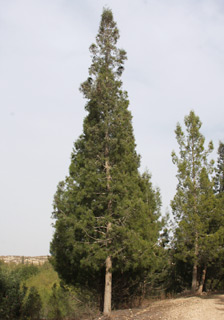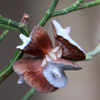Tetraclinis articulata, also known as Sandarac, is an evergreen coniferous tree in the cypress family Cupressaceae endemic to the western Mediterranean region. This is the only species in this genus.
It is native to northwestern Africa in the Atlas Mountains of Morocco, Algeria and Tunisia. Isolated populations occurring in Malta and near Cartagena, Spain. The populations of Tetraclinis articulata in Malta and southern Spain are highly threatened. In North Africa the species is also restricted in range. The species is listed as rare on the IUCN's Red List of plants, which notes that populations are vulnerable in Morocco. In Morocco, priority is given to in situ conservation within reserves and protected areas.
It grows at relatively low altitudes in a hot, dry subtropical Mediterranean climate. It is one of only a small number of conifers able to coppice (re-grow by sprouting from stumps), an adaptation to survive wildfire and moderate levels of browsing by animals. Old trees that have sprouted repeatedly over a long period form large burrs at the base.
Tetraclinis articulata is a slow-growing tree, to 6–15 m (rarely 20 m) tall and 0.5 m (rarely 1 m) trunk diameter, often with two or more trunks from the base. .” If it grows in rock fissures and rocky slopes it may grow up only to 5 m in height.
The foliage forms in open sprays with scale-like leaves 1–8 mm long and 1–1.5 mm broad; the leaves are arranged in opposite decussate pairs, with the successive pairs closely then distantly spaced, so forming apparent whorls of four. The cones are 10–15 mm long, green ripening brown in about 8 months from pollination, and have four thick scales arranged in two opposite pairs. The seeds are 5–7 mm long and 2 mm broad, with a 3–4 mm broad papery wing on each side.
People make use of the resin, gum sandrac, that exudes naturally on the stems of the tree. It is also gotten by making cuts on the bark. It solidifies when exposed to the air. It comes to commerce in the form of small solid chips, translucent, and having a delicate yellow tinge. Morocco has been the main place of origin of sandarac. Historically, especially in the Late Medieval and Renaissance era, sandarac was used to make varnish. Its most outstanding property is its hardness. When "varnish" was spoken of in Renaissance Italy (Italian vernice) it usually meant sandarac. It is also used in powdered form to clean vellum and to prepare it for writing purposes.
In Arab countries sandarac is still burned to treat colds. People also take the resin internally to treat roundworms and tapeworms. The wood, particularly from burrs at the base of the trunk, is used for decorative woodwork.
Written by Amram Eshel





